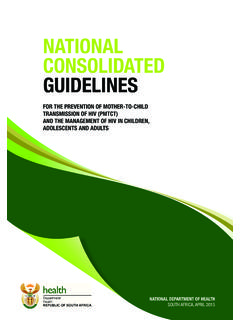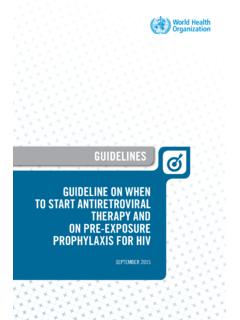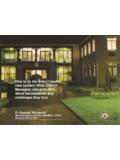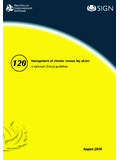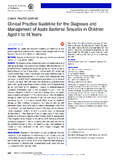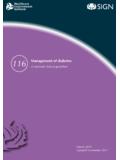Transcription of GUIDELINE ORIGINAL ARTICLE GUIDELINE Adult …
1 GUIDELINEDECEMBER 2014, Vol. 15, No. 4 SAJHIVMED 121 ORIGINAL ARTICLEGUIDELINEA dult antiretroviral therapy guidelines 2014By the Southern African HIV Clinicians SocietyG Meintjes (chairperson)J Black, F Conradie, V Cox, S Dlamini, J Fabian, G Maartens, T Manzini, M Mathe, C Menezes, M Moorhouse, Y Moosa, J Nash, C Orrell, Y Pakade, F Venter, D Wilson (expert panel members)Correspondence: Southern African HIV Clinicians Society Specific recommendations provided here are intended only as a guide to clinical management, based on expert consensus and best current evidence. Treatment decisions for patients should be made by their responsible clinicians, with due consideration for individual circumstances.
2 The most current version of this document should always be guidelines are intended as an update to those published in the Southern African Journal of HIV Medicine in 2012. Since the release of the previous guidelines , the scale-up of antiretroviral therapy (ART) in southern Africa has continued. Cohort studies from the region show excellent clinical outcomes; however, ART is still being initiated late (in advanced disease) in some patients, resulting in relatively high early mortality rates. New data on antiretroviral drugs have become available. Although currently few, there are patients in the region who are failing protease-inhibitor-based second-line regimens.
3 To address this, guidelines on third-line therapy have been Afr J HIV Med 2014;15(4):121-143. Key principlesWhile many antiretroviral therapy (ART) guidelines are available inter nation ally, the current guidelines have been written to add-ress issues relevant to southern Africa. The following general principles underpinned the writing process: South Africa (SA) is a middle-income country, whereas certain other countries in the region are low-income countries; therefore, affordability was taken into account. Only treatment and diagnostic options available in southern Africa were included. We recognised the need to bridge the gap in treatment recommendations between public and private sector programmes, considering that many patients transition between the two sectors for treatment.
4 While it is acknowledged that certain recommendations are aspirational for poorly resourced settings, the unavailability of diagnostic/monitoring tests should not pose a barrier to providing ART to those in need. There has been a shift to view ART as a means of HIV prevent-ion. The clinical trial evidence base for this exists for serodiscordant couples; recommendations in this regard are included in these guidelines and additional data from randomised community studies are Goals of ARTThe primary goals of ART are to: improve quality of life reduce HIV-related morbidity and mortality provide maximal and durable suppression of viral load (VL) restore and/or preserve immune goals are achieved by suppressing viral replication completely for as long as possible, using well-tolerated and sustainable treatment taken with good adherence.
5 With prolonged viral suppression, the CD4+ lymphocyte count usually increases, which is accompanied by a restoration of pathogen-specific immune function. For most patients, this results in a dramatic reduction in the risk of HIV-associated morbidity and mortality. It is still unclear whether immune function ever returns to full normality. Long-term cohorts show that patients who adhere well to ART have a near-normal life expectancy.[1]3. Standard of careMaximally suppressive ART regimens should be used in HIV-positive individuals to obtain the best results and to prevent resistance. However, non-suppressive regimens have a role in HIV prevention, in the prevention of mother-to-child transmission (PMTCT) (infant prophylaxis), in post-exposure prophylaxis (PEP) for healthcare workers following certain low-risk occupational exposures, and in pre-exposure prophylaxis (PrEP).
6 Furthermore, these regimens are probably effective in HIV-negative individuals following low-risk sexual exposures. For further guidance see: Southern African HIV Clinicians Society. Post-exposure prophylaxis. S Afr J HIV Med 2008;9(3):36-45. (An update will be published in 2015.)GUIDELINE122 DECEMBER 2014, Vol. 15, No. 4 SAJHIVMEDGUIDELINE4. antiretroviral (ARV) agents: Classes and mechanisms of actionThere are currently five classes of ARVs available in southern Africa (Table 1). The most commonly used ARV agents inhibit one of three key HIV enzymes required by the virus for intracellular replication: reverse transcriptase: essential for completion of the early stages of HIV replication protease: required for the assembly and maturation of infectious viral progeny integrase: required for the integration of proviral DNA into the host chromosomal ARV agents currently available in southern Africa The ARV agents currently available in southern Africa are summarised in Table 2.
7 Different fixed-dose combinations (FDCs) are increasingly being made available. The oldest combination is zidovudine (AZT)/lamivudine (3TC), but a number of other two- and three-drug FDCs are now available in the region. These FDCs reduce the burden of multiple pills and may improve treatment adherence. 6. Indications for initiating ART Indications for ART initiation are summarised in Table 3. ART initiation is hardly ever an emergency, unless used for PEP or PMTCT. However, patients with profound immunosuppression are at significant risk of opportunistic infections (OIs) and associated mortality, and should be assessed rapidly and initiated on ART within 1 - 2 weeks once adherence counselling has been initiated.
8 In patients with higher CD4+ counts, ART should be deferred until patients are prepared to commit to long-term treatment and are main taining good treatment adherence. However, in eligible patients, efforts should be made to avoid lengthy indecision that may result in avoidable clinical deterioration and Rationale for these CD4+ thresholdAll patients with a CD4+ count <350 cells/ L should be advised and encouraged to start ART without delay. There is clinical evidence that this reduces mortality: a randomised trial in Haiti demonstrated reduced mortality and incident tuberculosis (TB) in patients starting ART at a CD4+ count threshold of <350 cells/ L (compared with patients waiting to commence therapy at a threshold of <200 cells/ L).
9 [2]Evidence is less clear concerning individual patient benefit when in creasing the CD4+ count threshold for ART initiation to 500 cells/ L. No clinical trial has shown improved patient survival from starting ART at a CD4+ count >350 cells/ L. Such trials are ongoing. Some observational data suggest that reduced morbidity and mortality are associated with starting ART earlier (at CD4+ count thresholds of 500 cells/ L).[3-6] However, these data are derived from retrospective studies with methodological issues and probable residual confounding. If there is benefit to patients starting ART at CD4+ counts >350 cells/ L, the benefit is likely to be small, since HIV-related events at high CD4+ counts are rare.
10 A randomised controlled trial (RCT) (HIV Prevention Trials Network 052 (HPTN052)) showed reduced morbidity but not mortality associated with starting ART at a CD4+ count of 350 - 550 cells/ L (v. <250 cells/ L).[7] However, again the absolute benefits were small. Definitive evidence regarding earlier ART initiation is awaited from ongoing RCTs, including the START (Strategic Timing of ART; ) and TEMPRANO (Early antiretroviral Treatment and/or Early Isoniazid Prophylaxis Against Tuberculosis in HIV-infected adults ) , there is evidence that starting ART at higher CD4+ counts reduces HIV transmission within couples where one partner is HIV-negative (HPTN052) (see below),[7] and wider ART coverage appears to reduce the risk of HIV transmission at a community level.
